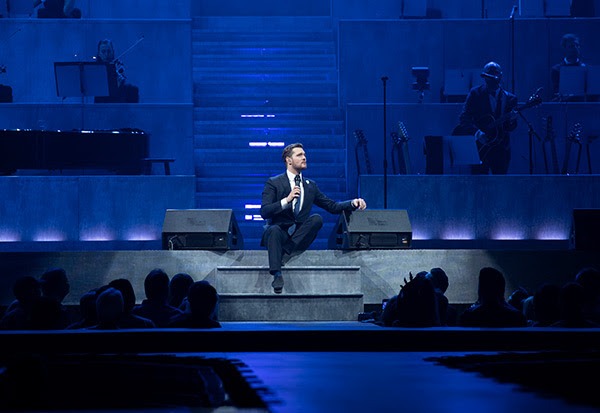After a four year touring hiatus, pop megastar Michael Bublé has returned to his adoring fans for 91 shows in North America and Europe. Dubbed “An Evening with Michael Bublé”, the 2019 edition relies — as have Bublé’s tours for nearly a dozen years — on a Meyer Sound system supplied by Montreal-based Solotech.
Although the core LEO Family loudspeaker components are similar to those used in Bublé’s 2013 outing, for this tour the configuration has been altered dramatically to remedy monitoring issues and also to provide a more intuitive experience for the audience. Essentially, this “dual hybrid” audio configuration complements and enhances the production’s split staging: a large end-stage accommodating a full orchestra and background singers (up to 38 in total), and a smaller B stage centred in the arena and connected to the main stage by a catwalk.
The main stage audio system, which anchors the orchestra image and covers the bowl seating up to about halfway back into the arena, comprises typical side and main arrays, but with the main front arrays canted off to the side, as they are not directed for vocal coverage of the rear portion of the arena. That job is handled by a separate multi-array system flown under the scoreboard, with the two most powerful arrays here covering the rear seating bowl by functioning essentially as a massive delay cluster whenever Bublé is performing on the main stage.
However, when Bublé walks out to the central B stage, the “zero point” of his voice follows along, transitioning in sync so that when he arrives, his voice is securely anchored directly overhead while the orchestra image remains at the main stage.
As explained by Craig Doubet, Bublé’s FOH engineer since 2007, the original impetus for this novel setup came from Bublé himself.
“Michael loves getting out into the audience on a B stage, which he has done the last two tours, but he was having a problem with his vocal from the main stage PA bleeding into his mic and then going into his IEMs. It’s distracting when you have a delay of 125 to 160 milliseconds coming back into your ears when you’re trying to sing.”
When preparing for the tour, Doubet sat down for a brainstorming session with Meyer Sound Director of System Optimisation Bob McCarthy, Senior Technical Support Specialist David Vincent and Digital Systems Product Manager Rob Mele to sketch out possible solutions. The particulars were later engineered in collaboration with the tour’s System Engineer/Crew Chief Jonathan Trudeau and Solotech Audio Projects Manager Patrice Lavoie.
“The upshot is that now Michael is never directly in front of a loudspeaker,” said Doubet. “When he goes to the B stage, we move his vocal along using some newly developed software in GALAXY™. What’s more, in a segment of the show where a small band joins him at the B stage to evoke his days playing clubs, the main stage system is turned completely off and we bring up a pair of back-facing LEOPARD arrays to create a self-standing, in-the-round arena system. Michael is now very happy. We’ve made him feel like he’s always singing at the zero point.”
The innovations also help foster a more natural and intimate relationship between artist and audience. “There’s never a disconnect between where you see Michael and where you hear his voice coming from,” said Doubet. “When you see him go over there, his voice goes over there.”
The main stage system for the tour comprises a total of 16 LEO and 44 LYON line array loudspeakers configured across the front/out and side systems. Twelve 1100-LFC low-frequency control elements are flown at the main stage, with front fill from eight MINA and two JM-1P loudspeakers and floor bass anchored by four 900-LFC elements.
The B stage system comprises two long-throw arrays each with five LEO-M and six MICA line array loudspeakers; side arrays of 14 each MICA loudspeakers; and stage-facing rear arrays of eight-each LEOPARD line array loudspeakers. Flown subwoofers here are 12 700-HP, with two 900-LFC elements on the floor along with 7 MINA loudspeakers for front fill. System drive and optimisation are supplied by a GALAXY 816 AES master processor networked via AVB with seven GALAXY 816 array processors.
This novel configuration aside, the basic elements of the system deliver as expected for Doubet. “I grew up in this business with the MSL-5 and 6, which were for me the epitome of a vocal box. LEO sounds like that to me, except it has more power and versatility. Here LEOs are configured to cover the upper decks and it’s beautiful up there — out front as it should be, but rich and smooth all the time.”
He also applauded the consistency of the entire LEO Family, including the LEOPARD arrays which are out for the first time with Bublé. “I know I can tune all the boxes the same way and Michael’s vocal will be the same everywhere,” he said. “That’s really my focus for this tour.”
Overseeing all aspects of the intricate staging and AVL technology — filling 19 trucks — is veteran Production Manager Dean Roney, who filled that role on Bublé’s tours since 2005. From Roney’s perspective, Meyer Sound technology and support have proven critical.
“Because of the unique set-up, with around 50 hang points for audio, having all self-powered loudspeakers was essential,” he commented. “And, as usual, Meyer Sound support is awesome. Their team took care of a great deal of paperwork and programming in advance, so we were ready to go from day one.”
Also contributing to the sonic excellence of the tour, alongside Trudeau, are monitor engineers Marc Depratto and Louis-Philippe Maziade.
“An Evening with Michael Bublé” launched on February 13 and toured North America through April 19. From May 20 through November 10 the tour alternates between Europe and North America, with additional dates around the globe through next summer to be announced soon.






